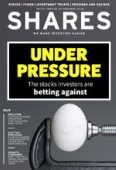Archived article
Please note that tax, investment, pension and ISA rules can change and the information and any views contained in this article may now be inaccurate.
Why you need to know about dealing spreads when buying and selling shares

In an age where everything is digital, and buying shares no longer means having to physically take delivery of paper share certificates, it’s tempting to assume you can deal at the touch of a button at any time during the day and get the same price you see on your screen.
However, that price is just an illusion which lasts only the time it takes the market to match similar-sized buyers and sellers.
Underlying the whole system is the bid-offer spread, which is the difference between the best price at which you can sell shares and the best price you can buy them.
Depending on the stock and accounting for other variables such as underlying liquidity, market volatility and news flow, the spread could be a fraction of a percent of the share price, or it could be wide enough to drive a double-decker bus through.
BUYER (AND SELLER) BEWARE
Back before the ‘Big Bang’ financial reforms of 1986, which saw share trading move from the floor of the London Stock Exchange to computer screens in offices, all deals were struck in person between ‘brokers’ and ‘jobbers’.
Brokers traded shares on behalf of their customers while jobbers traded for their own account, meaning they put their own capital at risk.
Jobbers are now called ‘market-makers’, ‘Retail Service Providers’ or RSPs for short. These firms commit to make firm two-way prices based on the underlying stock exchange, e.g the SETS order book for the London Stock Exchange.
The market makers may quote prices for all stocks listed on an exchange or they may specialise in certain segments or markets, for example FTSE 350, AIM or US stocks. These firms ensure the liquidity needed for retail investors to trade instantly through today’s range of digital channels.
The issue for private investors is that the price displayed on most financial websites and some platforms can reflect the last trade, which is typically somewhere between the best bid and the best offer, and not necessarily the same price you will get if you try to buy or sell yourself ‘at market’.
UNDERSTANDING LIMITS
In some cases, rather than opting to deal at market you can enter an order with a price limit. These orders are tracked electronically until your chosen limit price is reached, but it may not be completed or ‘dealt’ depending on the underlying liquidity of the shares.
For FTSE 100 stocks, if you put on a ‘limit order’ somewhere between the best bid and the best offer you are more than likely to get that price whether you are buying or selling.
Alternatively, you can put in a buy order below the market price or a sell order above the market price and leave it there for a few days or a few weeks until it expires. You may or may not be successful, but that is the chance you take.
With less liquid stocks, you may still be able to place a limit order but even though you might see the shares trade at that price there is no guarantee your order will be filled.
For example, if you want to sell 10,000 shares at say 100p but the bid is only for 5,000 shares at that price your order can’t be executed.
In this scenario your broker or platform may partially fill your limit order and leave the balance on until its expiry date.
Typically, once you have entered a limit order you can’t change the limit, all you can do is cancel the order and put in a new order at a different price.
MIND THE GAP
In general, larger companies have the tightest bid-offer spreads and the greatest liquidity in terms of the amounts of shares traded every day.
The spread for a FTSE 100 company like Unilever (ULVR) can be as tight as one basis point (100 basis points is 1%), but it is important to understand that spreads aren’t set in stone, and they can move around.
Also, as you might expect, supply and demand affect the volume of shares traded. For example, results announcements and corporate events such as acquisitions attract three more times the average daily volume.
The percentage of free float, that is the proportion of shares publicly traded and not held in long-term ownership by major stakeholders, also has an influence on the amount of daily liquidity and spread.
If you invest in smaller-cap names, they are likely to have wider spreads and lower daily volumes which means it is often easier to execute orders when they have a trading update or results announcement.
Market volatility and the state of the economy also have an impact on trading volumes and spreads. Rising interest rates and the war in Ukraine have increased the risk of recession as acknowledged by the Bank of England.
If the UK market were to enter a bear market, it is important to be aware that this could result in lower trading volumes and wider bid-offer spreads. A bear market is when the overall market falls in value by 20% or more from the previous high.
In that event or when market volatility is elevated, what you thought was a relatively easy stock to sell might turn out not to be.
TIGHEST AND WIDEST
Shares has used Stockopedia software to identify those areas of the UK market which have the tightest spreads as well as examples of some of the widest. We have excluded investment trusts and Russian stocks.
Roughly 90% of the FTSE 100 and 60% of the FTSE 350 have bid-offer spreads of less than 20 basis points. Unsurprisingly the narrowest spreads are FTSE 100 names.
But interestingly, market capitalisation doesn’t tell the whole story and the number of shares traded seems to influence the tightness of the spread.
Banking group Lloyds Bank (LLOY) is only a fifth the size of pharma giant AstraZeneca (AZN), but its dealing spread is almost half.
This might be explained by the fact that around 3% of Lloyd’s outstanding shares trade every day compared with only 0.2% for AstraZeneca.
The winner of the dubious honour of the widest spread in the FTSE 350 index goes to promotional products company 4Imprint (FOUR) which had a dealing spread of 1.1% at the time of writing. This reflects a smaller average daily volume of shares traded which accounts for 0.1% of the company’s outstanding shares.
KEEP COSTS LOW
It is important to consider the bid-offer spread and dealing charges when considering investments because these costs eat into potential returns.
You should also bear in mind that the wider the spread today, the chances are that in less favourable times it can increase further.
Companies with dealing spreads above 5% means the shares must gain more than 10% before commissions just for an investor to break-even.
Surprisingly, there are over 500 companies on the UK market which fall into this category so it can pay to do your research before deciding whether to buy shares in certain companies.
Important information:
These articles are provided by Shares magazine which is published by AJ Bell Media, a part of AJ Bell. Shares is not written by AJ Bell.
Shares is provided for your general information and use and is not a personal recommendation to invest. It is not intended to be relied upon by you in making or not making any investment decisions. The investments referred to in these articles will not be suitable for all investors. If in doubt please seek appropriate independent financial advice.
Investors acting on the information in these articles do so at their own risk and AJ Bell Media and its staff do not accept liability for losses suffered by investors as a result of their investment decisions.
Issue contents
Education
Feature
Great Ideas
Investment Trusts
News
- Supermarket sales slide extends to over a year as shoppers trade down
- Trustpilot pulls forward breakeven target at its big investor day
- Henderson manager hits the sell button on Shell
- Why Primark's plan to trial new click and collect service could be smart
- How rising interest rates are increasing the risk of recession

 magazine
magazine








